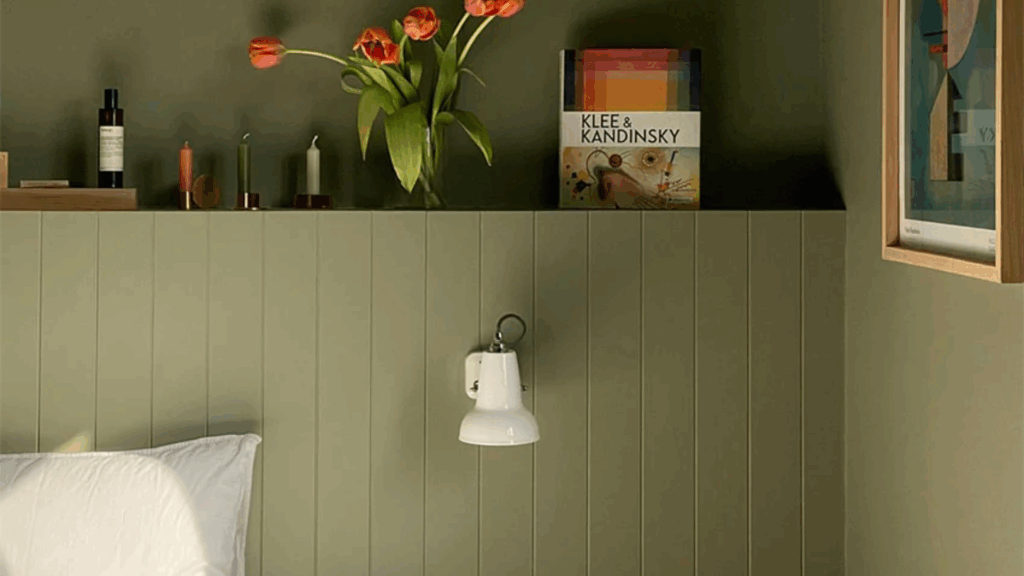Louisburg Green (HC-113) by Benjamin Moore is a medium green with a soft, earthy feel. Its gray undertones give it a cool, muted look, which makes it calm and easy to use in many spaces.
Louisburg Green is part of the Historic Color Collection, a group of timeless shades inspired by traditional American homes.
It has a Light Reflectance Value (LRV) of 33.79, meaning it reflects a moderate amount of light. It won’t make a room feel too dark, but it still adds depth.
In this post, I’ll cover why Louisburg Green works well in different rooms, how lighting affects its undertones, flooring and decor ideas that match nicely, and how it compares to other warm neutral paints.
If you like soft, natural colors with a classic feel, this one might be worth a closer look.
Why Louisburg Green Is an Ideal Paint Color for Any Room?

Louisburg Green (HC-113) is a color that fits almost anywhere. It’s soft, steady, and easy on the eyes, making it a safe choice for many homes.
This green works in both modern spaces and traditional rooms. It blends in without feeling boring and I think this color easily stands out without being too strong.
You can use it on walls, cabinets, trim, or built-ins. It adapts to the space without taking over. Here’s why it works so well:
- Soft and muted, not sharp or loud
- Adds a sense of warmth and comfort
- Works in large rooms and small spaces
- Helps create a calm and relaxed feeling
Understanding the Subtle Undertones of Louisburg Green
Louisburg Green (HC-113) is more than just a medium green. It has hidden undertones that give it a unique personality. These undertones are what make the color feel warm, calm, and natural.
The main undertones in Louisburg Green are yellow-brown, but there’s also a hint of gray. This mix gives the paint a soft, slightly muted look. It’s not too bright, and it doesn’t feel cold.
These undertones shift with the light, which changes how the color looks in different rooms or at other times of day. Here’s what you might notice:
- In natural daylight, Louisburg Green looks greener and fresh. It feels light and peaceful.
- Under warm bulbs, the yellow and brown tones come forward. It takes on an olive-like look, perfect for cozy spaces.
- In cool lighting, like daylight LEDs or cloudy weather, it can look more muted or even slightly brown or gray. This gives it a calm and steady feel.
Best Places to Use Louisburg Green in Your Home
Louisburg Green (HC-113) is a soft, natural-looking green that works in many areas of the home. It’s warm but not too dark, so it helps rooms feel cozy without feeling small. Its calm tone makes it a good fit for both large spaces and tighter corners.
Living Rooms
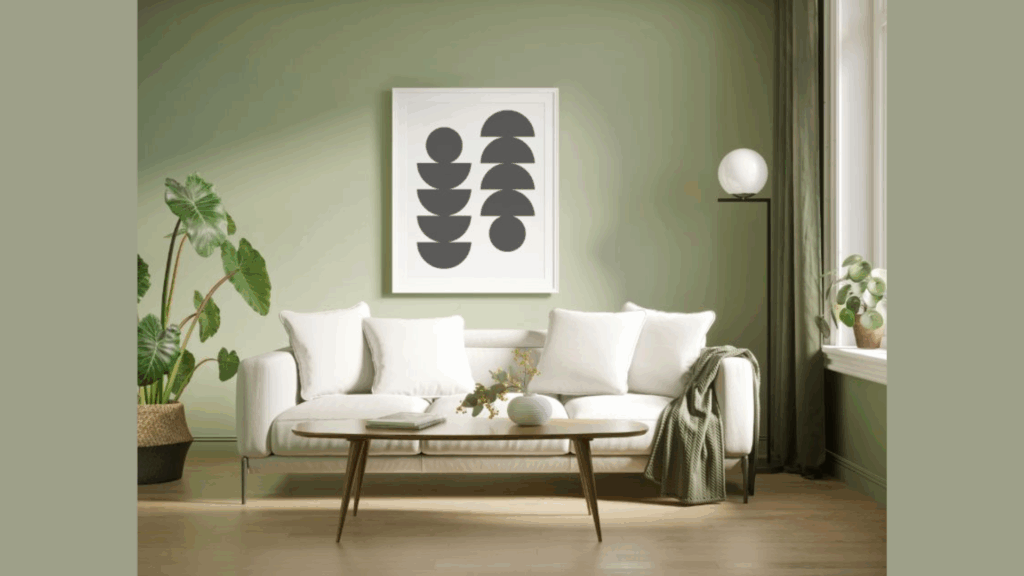
Louisburg Green creates a relaxed, peaceful feel in living rooms. It works especially well with warm wood furniture, soft lighting, or a neutral sofa. You can paint all four walls for a cozy vibe, like I’ve done in my home, or just one wall to make it stand out behind a couch or fireplace.
Bedrooms
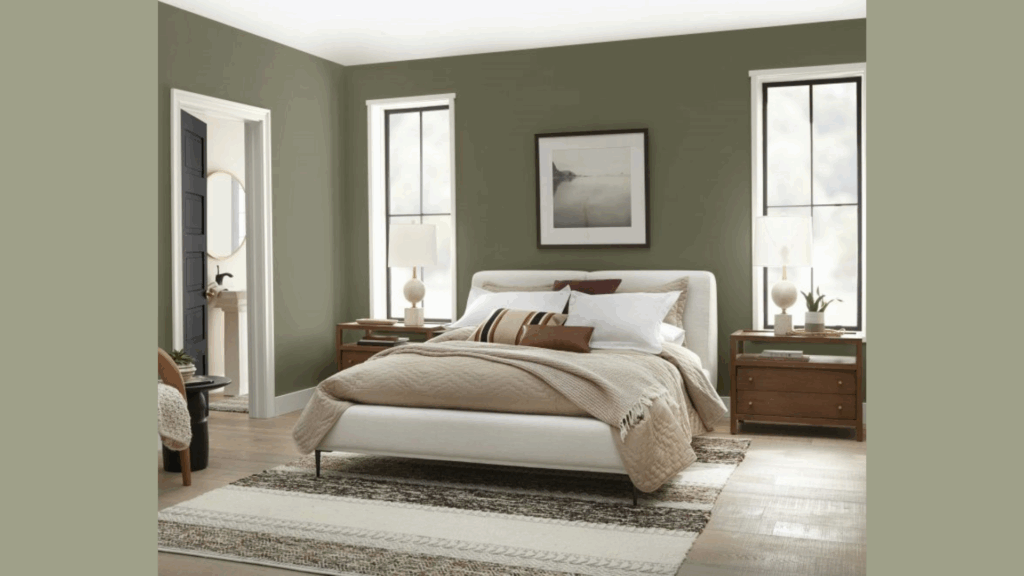
This green brings a sense of calm and comfort to bedrooms. It pairs nicely with white or cream bedding and natural wood nightstands. Use it behind the headboard for a soft backdrop or cover the whole room if you want a restful, grounded space.
Dining Rooms
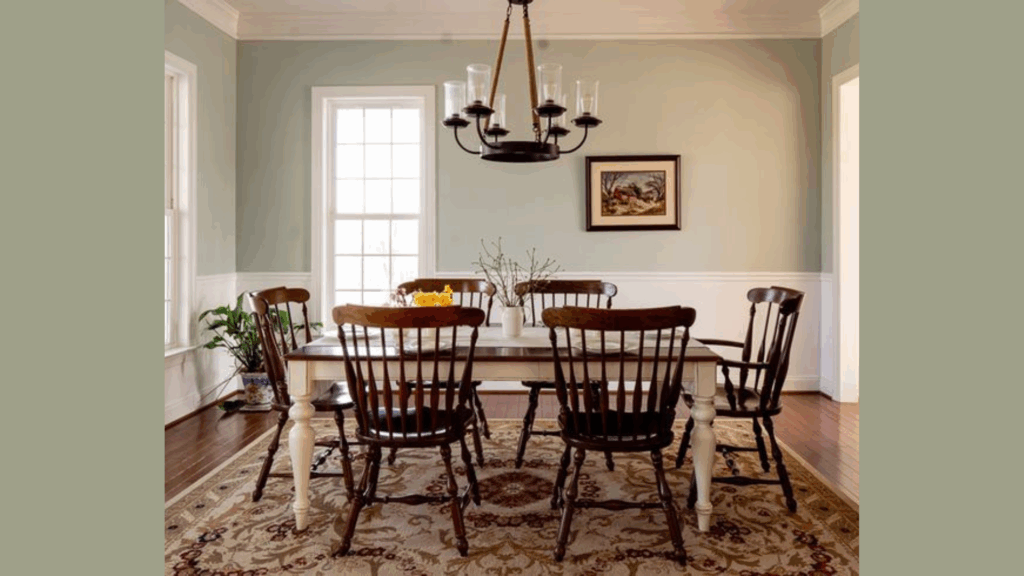
This color adds warmth and richness to dining areas without being too strong. It looks great with wood tables, brass light fixtures, or classic trim. The green helps the space feel more inviting, making it a good choice for family dinners or hosting guests.
Entryways and Hallways
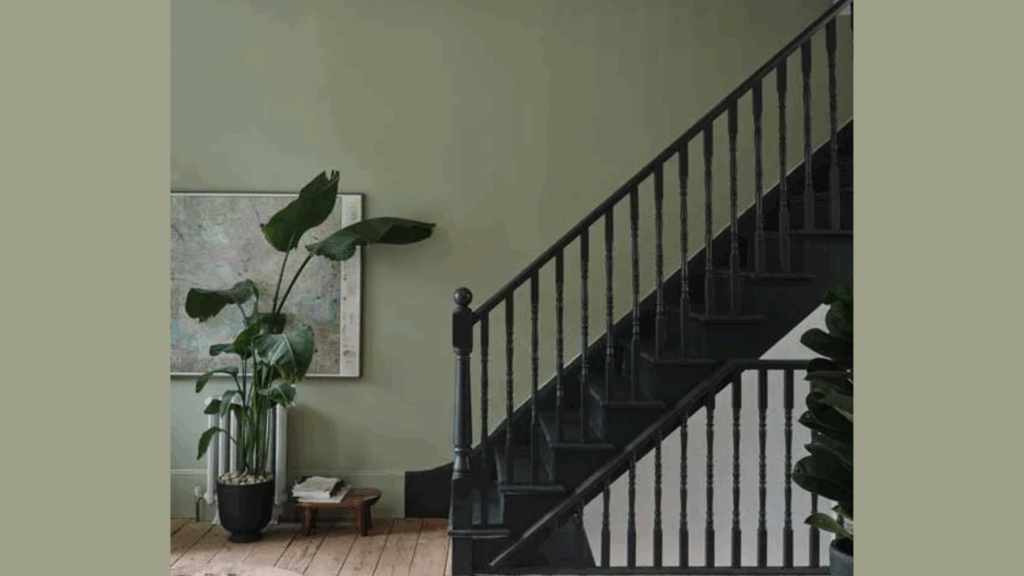
These are often overlooked spaces, but a color like Louisburg Green can bring them to life. It adds depth and interest without being too bold. Try it in a hallway with light wood floors or an entryway with a simple rug and mirror. It creates a welcoming feel right as you walk in.
Flooring Options That Pair Beautifully with Louisburg Green
The right floor can change how Louisburg Green (HC-113) looks and feels. This soft green works with many flooring styles, each bringing out a different aspect of the color.
Light Wood or Oak Floors
Light wood helps brighten up the room, adds contrast, and keeps the space feeling fresh. This combo works well in living rooms, bedrooms, and open spaces.
- Makes the green feel soft and clean
- Great for modern or farmhouse styles
- Adds a natural, easy look
Warm-Toned Hardwood
Medium or rich wood tones bring out the warm undertones in Louisburg Green. Together, they create a cozy, classic feel.
- Works well in dining rooms and hallways
- Feels timeless and grounded
- Matches with vintage or traditional furniture
Terracotta Tiles
Terracotta adds earthy warmth to the space. Its red-orange tones highlight the natural side of the green.
- Good for kitchens, mudrooms, and entryways
- Makes the room feel rustic and welcoming
- Pairs well with woven textures and plants
Neutral Carpets and Rugs
Soft flooring keeps things calm and simple. Rugs in beige, cream, or warm gray will let the green stand out.
- Adds comfort to bedrooms and living rooms
- Helps balance deeper wall colors
- Works with most decor styles
Creative Ways to Decorate with Louisburg Green
Louisburg Green (HC-113) is easy to decorate with. It works with many styles and finishes. Whether your space is classic or modern, this soft green adds a nice touch without being too bold.
Accent Furniture and Finishes
The following materials help balance the color and give it character.
- Wood furniture – oak, walnut, pine
- Brass or gold – warm metals add a soft shine
- Black metal – for contrast and clean lines
Complementary Trim and Décor Colors
To bring out the best in Louisburg Green, these colors help the green feel grounded and calm.
- Off-whites – clean and classic
- Dusty pinks – soft contrast that feels warm
- Warm neutrals – beige, taupe, and soft browns
Use Texture to Add Depth
Layering different textures makes the room feel complete. Texture adds interest without adding more color.
- Rugs – jute, wool, or soft cotton
- Throw pillows – in solid tones or simple patterns
- Wall art – framed prints, wood accents, or fabric pieces
Louisburg Green Compared to Other Warm Neutral Paints
Louisburg Green (HC-113) is just one of many soft greens in the Benjamin Moore collection. Each shade has its tone and mood. Here’s how it compares to a few other popular options:
| Paint Color | Tone | Undertones | Best Use |
|---|---|---|---|
| Louisburg Green (HC-113) | Medium, muted green | Warm yellow-brown, gray | Bedrooms, living rooms, dining rooms |
| Webster Green (HC-130) | Darker green | Slightly warm, earthy | Accent walls, cabinets, offices |
| Saybrook Sage (HC-114) | Light, soft green | Cool gray-green | Kitchens, bathrooms, sunlit spaces |
| Tate Olive (HC-112) | Warm olive tone | Yellow-brown | Hallways, cozy corners, traditional homes |
| October Mist (1495) | Pale green | Silver-gray | Whole rooms, minimal or modern spaces |
When to Choose Louisburg Green
It’s a good in-between shade—not too dark, not too pale. The gray in it keeps it calm while the warm tones make it feel inviting. Pick Louisburg Green if you want a color that is:
- Softer than Webster Green
- Warmer than Saybrook Sage
- Milder than Tate Olive
- Richer than October Mist
Tip: Try samples of two or three greens side by side. See how they look in your space, under your lighting. Even small shifts in undertones can make a big difference.
Conclusion
Louisburg Green (HC-113) is a soft, muted green that feels both classic and comfortable. Its warm undertones and gray base give it a calm, natural look that fits well in many homes.
You can use it in Living rooms for a cozy feel, bedrooms for calm and comfort, dining areas for a warm, welcoming mood, and cabinets, trim, or doors for a subtle pop of color.
Before painting a full room, test a sample first. Look at it in morning light, evening light, and under your bulbs. This will help you see the color’s true tone and how it shifts throughout the day.
If you’re looking for warm, steady, and timeless paint, Louisburg Green is a strong choice. It’s easy to live with and adds just enough color to make a space feel finished.

